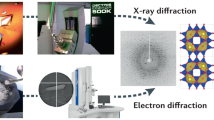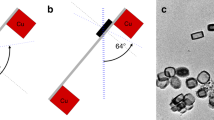Abstract
WITH advances in microscope design, high-resolution electron microscopy has become routine, and resolutions of less than 2 Å have been obtained for many inorganic crystals1–4. The images provide a representation of the Coulomb potential (essentially the electron density), but interpretation generally requires comparing experimental images with calculations5. Because the images are two-dimensional representations of the full three-dimensional structure, information is invariably lost. In particular, oxygen atoms are normally not seen. The technique of electron crystallography, in which information from several views of a crystal is combined, has been developed to obtain three-dimensional information on proteins6–8. Here we use this technique to obtain a three-dimensional reconstruction of the crystal structure of staurolite, a silicate mineral. We are able to identify the positions of oxygen atoms in the lattice. These results show the potential of the method for high-resolution structure determination on samples that are too small for the use of X-ray techniques.
This is a preview of subscription content, access via your institution
Access options
Subscribe to this journal
Receive 51 print issues and online access
$199.00 per year
only $3.90 per issue
Buy this article
- Purchase on Springer Link
- Instant access to full article PDF
Prices may be subject to local taxes which are calculated during checkout
Similar content being viewed by others
References
Hashimoto, H., Endoh, H., Tanji, T., Ono, A. & Watanabe, E. J. phys. Soc. Japan 42, 1073–1074 (1977).
Smith D. J. et al. Ultramicroscopy 18, 63–76 (1985).
Gronsky, R. Proc. 38th A. Mtg Electron Microscopy Soc. Am., 2–5 (Claitors, Baton Rouge, 1980).
Veblen, D. R. & Buseck, P. R. Science 206, 1398–1400 (1979).
O'Keefe, M. A., Buseck, P. R. & Iijima, S. Nature 274, 322–324 (1978).
Amos, L. A., Henderson, R. & Unwin, P. N. T. Prog. Biophys. molec. Biol. 39, 183–231 (1982).
Glaeser, R. M. A. Rev. phys. Chem. 36, 243–275 (1985).
Henderson, R. & Unwin, P. N. T. Nature 257, 28–32 (1975).
Henderson, R. et al. J. molec. Biol. 213, 899–929 (1990).
Hovmöller, S., Sjögren, A., Farrants, G., Sundberg, M. & Marinder, B. O. Nature 311, 238–241 (1984).
Smith, J. V. Am. Miner. 53, 1139–1155 (1968).
Kilaas, R. Proc. 45th A. Mtg Electron Microscopy Soc. Am. 66–69 (San Francisco Press, 1987).
Hetherington, C. J. D., Nelson, E. C., Westmacott, K. H., Gronsky, R. & Thomas, G. Proc. Symp. 139 Mater. Res. Soc. (eds Ponce, F. A. & Smith, D. J.) 277–282 (1989).
Author information
Authors and Affiliations
Rights and permissions
About this article
Cite this article
Downing, K., Meisheng, H., Wenk, HR. et al. Resolution of oxygen atoms in staurolite by three-dimensional transmission electron microscopy. Nature 348, 525–528 (1990). https://doi.org/10.1038/348525a0
Received:
Accepted:
Issue Date:
DOI: https://doi.org/10.1038/348525a0
This article is cited by
-
Atomic resolution of lithium ions in LiCoO2
Nature Materials (2003)
-
A crystal structure determined with 0.02 Å accuracy by electron microscopy
Nature (1996)
-
Electron crystallography of inorganic compounds. Direct determination of the basic copper chloride structure CuCl2·3Cu(OH)2
Journal of Chemical Crystallography (1994)
Comments
By submitting a comment you agree to abide by our Terms and Community Guidelines. If you find something abusive or that does not comply with our terms or guidelines please flag it as inappropriate.



